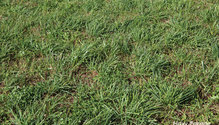From hayfield to pasture |
| By Jim Gerrish |
|
|
|
The author is a rancher, author, speaker, and consultant with over 40 years of experience in grazing management research, outreach, and practice. He has lived and grazed livestock in hot, humid Missouri and cold, dry Idaho.  The first objective of conversion is to get something else growing in addition to alfalfa. Mike Rankin I talk with a lot of farmers and ranchers all across the country who are trying to transition away from hay dependence toward more dormant-season grazing. A common question I get is how to convert an alfalfa hayfield into a grazable pasture. Sometimes the field may still have quite a strong alfalfa stand while others may be fields in decline. Grazing an alfalfa field is a pretty scary prospect for a lot of livestock producers. The fear of bloat is pervasive throughout our industry. I have long maintained that the fear of bloat costs cattle and sheep producers far more than the actual losses due to bloat. That is financially true on an industry-wide scale. It is not quite so true when you’re the one who walks out one morning to find fifty dead animals. When bloat does occur, it is usually operator error. In other words, the bloat event was probably preventable if the manager had been paying more attention to what was going on. Stage of maturity, timing of the pasture move, frequency of moving, and severity of use are all factors that can set up a bloat event. There is also a strong animal genetic component. We can intentionally select for bloat resistance. Grass will help When we decide to convert an alfalfa field from hay to pasture, one of our first objectives is to get something else growing out there besides just alfalfa. As little as 15% grass component in an alfalfa field has been shown to reduce the occurrence of bloat. If alfalfa is the only legume in the pasture, my preference is that it be less than 50% of the total biomass production. The remaining production should be from grass and high-tannin forbs that can substantially reduce the likelihood of bloat occurring even in bloat-susceptible herds. A pure stand of alfalfa is made up of individual alfalfa plants that have strong crowns. Plants are generally spaced apart with open ground between the crowns. A healthy, productive alfalfa stand typically has four to seven mature plants per square foot. There is a lot of space in between plants where other species can have a chance to grow. With the advent of Roundup Ready alfalfa varieties, the possibility of later summer weed competition has already been minimized. Timing of interseeding depends on your location. If you plan to interseed cool-season grasses, we generally plan for an August through early September seeding date. No-till drilling immediately following hay harvest has worked well for us in environments from Idaho to Missouri. Success rate is very high in irrigated environments. In the Intermountain region and the Northern Plains, we seed in mid-August with irrigation following the drilling. In the Midwest and eastern states, we are generally seeding the last week of August or first week of September and hope for rain. The reason we do the late-summer seeding when putting grass into alfalfa is based on the respective growth habits of the different species. In the spring, alfalfa grows really well and is competitive. It is hard to get grass seedlings going while alfalfa is growing full tilt. In later summer, alfalfa is heading for dormancy as days get shorter and nighttime temperatures dip. Cool-season grasses, on the other hand, want to grow in those same conditions. If you live in a warmer environment and are considering interseeding warm-season grasses, then we use a spring-seeding strategy. Depending on location, interseed the warm-season grasses following either the first or second cutting of the alfalfa. In either case, cut the alfalfa in prebud or bud stage. This will somewhat weaken the alfalfa and slow recovery. Leave taller residuals Once the interseeding is done and the grass seedlings emerge, it is still important to keep pressure on the alfalfa to minimize competition. A basic principle of grass-legume relationships is that short postgrazing residual favors legumes while taller residuals favor grass. Often, another potential alfalfa hay crop will regrow after the interseeding. Cutting this growth for hay is a good idea, but make sure to set the cutting height to be at least 4 inches. Six inches is even better because you are likely to be cutting above the tops of the grass seedlings at this height. Alfalfa is far from being my favorite legume for grazing. What we have done when the alfalfa has faded to about 30% yield contribution is broadcast seed of various clovers and birdsfoot trefoil into the pasture. Alfalfa cannot be maintained in a stand through natural reseeding. All of the clovers, vetches, and trefoil can be maintained indefinitely through natural reseeding. At some point in the summer, a 65- to 80-day recovery period is needed for these legumes to make seed. We have maintained strong legume stands for more than 15 years with natural reseeding. This article appeared in the August/September 2023 issue of Hay & Forage Grower on page 14. Not a subscriber? Click to get the print magazine. |
